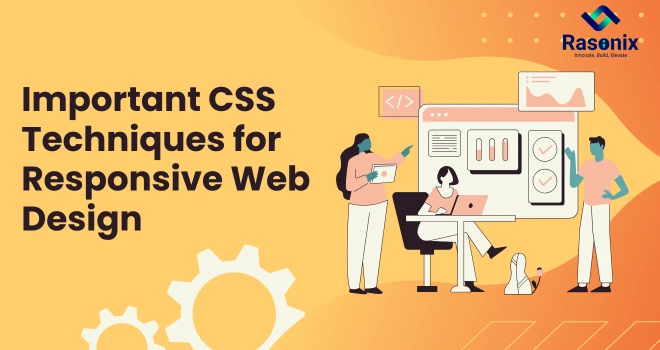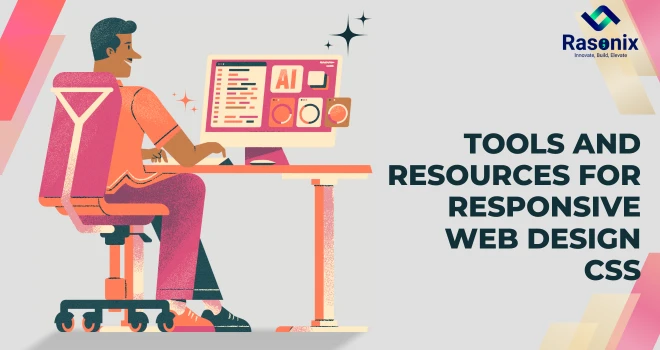In today's digital era, it isn't just beneficial but necessary for developers and businesses to use responsive web design CSS as website users are viewing websites on many different devices. Developers and businesses must ensure the website works properly whether the user is on their desktop, tablet, or mobile phone. When responsive web design CSS is employed, fluid layouts operationally react depending on screen size in order to enhance the user experience and offer a better search engine rank.
In this article, we will explore responsive web design CSS and basic principles like media queries, flexible grids, and new layout systems like CSS Grid and Flexbox. Whether you are a beginner in web development or a seasoned developer, this blog will assist you with helpful information on how to create a fully responsive website.
Understanding Responsive Web Design
Before we discuss the CSS methods, we must understand responsive web design CSS. Responsive web design CSS is a design process that helps web pages resize automatically for various screen sizes. Resizing of web pages is achieved using flexible grids, scalable images, and media queries.
Why is Responsive Design Important?
1. Improved User Experience: This provides for an easy and uniform experience over different devices.
2. SEO Boost: Google prefers mobile-friendly websites when ranking for a search.
3. Bigger Audience: This targets users on smartphones, tablets, laptops, and desktop computers.
4. Improved load times: Optimizing content delivery makes for an improved experience, and a quicker website, on mobile networks.
5. Cost: One website that doesn't require mobile or desktop versions!
Important CSS Techniques for Responsive Web Design

1. The Viewport Meta Tag:
The viewport meta tag is the foundation of CSS for responsive web design. Without it, mobile browsers will display web pages in a fixed layout, requiring an undue amount of zooming and scrolling from the user.
The tag tells the browser to display the page width in relation to the device's screen width, enabling CSS styles to be properly applied.
2. CSS Media Queries:
One of the most significant benefits of responsive web design CSS is media queries. Media queries enable designers to set alternative styles based on varying screen sizes, screen resolutions, and other attributes.
Example of a Basic Media Query:
|
@media screen and (max-width: 768px) {
body {
background-color: lightgray;
}
}
|
3. Flexible Grid Layouts
Rather than fixed-width patterns, responsive web design CSS is built on adaptive grids that proportionally resize.
|
.container {
display: grid;
grid-template-columns: repeat(auto-fit, minmax(300px, 1fr));
}
|
4. CSS Flexbox for Dynamic Layouts
Flexbox is a vital component of responsive web design CSS, providing improved alignment and spacing of elements.
|
.flex-container {
display: flex;
flex-wrap: wrap;
justify-content: space-between;
}
|
5. Scaling Images and Videos
Images should scale automatically to prevent overflow issues. Responsive web design CSS achieves this with the following:
|
img {
max-width: 100%;
height: auto;
}
|
For videos:
|
.video-container {
position: relative;
padding-bottom: 56.25%;
height: 0;
overflow: hidden;
}
.video-container iframe {
position: absolute;
width: 100%;
height: 100%;
}
|
6. Mobile-First Approach
Responsive web design CSS prefers a mobile-first approach, in which styles are initially applied for small screens and then tailored to larger screens using media queries.
|
body {
font-size: 14px;
}
@media screen and (min-width: 768px) {
body {
font-size: 16px;
}
}
|
7. Testing Responsive Designs
To make sure your responsive web design CSS implementation is correct, apply browser developer tools to mimic varied screen sizes and check performance.
Real-Time Mobile Usage Data and Responsive Design Effects
1. Mobile usage in 2024 represented 58.67% of world website traffic.
2. Google favours mobile-friendly or responsive design websites within its search engines.
3. Individuals are 67% more likely to purchase on a mobile-friendly website .
4. Slow-loading mobile websites receive higher bounce rates compared to quick websites.
5. Generally, mobile websites experience a 53% increase in bounce rate associated with slow-loading times caused by an unoptimized responsive design.
Common Responsive Design Issues and How to Fix Them
While responsive web design CSS has many advantages, there will be problems and challenges inherent to it that developers will have to contend with. Knowing what these challenges are and how to overcome them will make your site more responsive and enhance your own abilities.
1. Mobile Navigation:
There are numerous desktop navigational patterns that simply do not translate on smaller screens and mobile devices. You can adopt the mobile best-practice solutions employed in many apps such as hamburger menus, off-canvas navigation, or bottom navigation bars. The trick is to ensure the mobile solutions are both accessible and easy to grasp.
2. Responsive Images of Different Size:
Although it may fix most of your scaling problems, adding max-width: 100% alone does not stop displaying large images to small screens and mobile devices, and you'll be wasting bandwidth by sending large images that end up slowing down loading time, and ultimately defeat the overall user experience, which is what we all want to avoid. Investigate responsive images using the or the srcset attribute with the img tag in order to present images to varying screen sizes and resolutions.
3. Tables on Small Screens:
Occasionally it is difficult to display tabular formatted information on small screens. Occasionally the answer is to scroll the tables horizontally, limit the data in the table displayed to mobile devices, or change the table layout to a series of stacked blocks.
4. Uniform Visual Hierarchy Across Devices:
The weight and flow of the elements will vary significantly from desktop to mobile. Pay attention to the order and presentation of the elements at all different breakpoints to have a consistent and effective user experience.
5. Test on Actual Devices (No Emulators):
While browser developer tools are extremely useful, you really need to test on real physical devices of varying screen sizes and OS, to discover the problems in the real world. You might use a device testing service; or borrow-or purchase- some devices.
Code Snippet Showcase: Realistic Responsive Examples
To reinforce your knowledge of responsive web design CSS even more, let's see some real-world code snippets illustrating how to put together the methods we've covered.
Example 1: Basic Two-Column Layout Scaling Down to One Column on Small Screens
CSS
|
.row {
display: flex;
flex-wrap: wrap;
}
.column {
flex: 50%; /* Occupies 50% width on large screens */
padding: 15px;
}
@media screen and (max-width: 600px) {
.column {
flex: 100%; /* Fills up the whole width on small screens */
}
}
|
Example 2: Changing Font Sizes for Improved Mobile Readability
CSS
|
body {
font-size: 16px; /* Base font size */
}
h1 {
font-size: 2.5rem;
}
@media screen and (max-width: 480px) {
body {
font-size: 14px; /* Smaller font size on mobile */
}
h1 {
font-size: 2rem;
}
}
|
Tools and Resources for Responsive Web Design CSS

To further assist your learning as you try to master responsive web design CSS, the following tools and resources are at your disposal to streamline your workflow and learn more:
1. Browser Developer Tools (Chrome DevTools, Firefox Developer Tools, Safari Web Inspector): These very handy tools that enable you to inspect and debug your responsive layouts in real-time directly within the browser.
2. Online Responsive Design Testing Tools (as mentioned above): These are useful when you want to quickly test your page on multiple simulated devices.
3. CSS Frameworks (Bootstrap, Foundation): These frameworks have pre-built responsive grids and components and can speed up the responsive design process. Our goal in this post was to be as close to responsive web design CSS as possible, but these frameworks can be very useful and powerful.
4. CSS Preprocessors (Sass, Less): These enable you to utilize variables, nesting, and mixins to make it a lot simpler to write and modify the responsive design CSS.
5. Online Docs and Tutorials (MDN Web Docs, CSS-Tricks, Smashing Magazine): These are wonderful resources to locate articles, tutorials, and documentation on everything CSS, responsive design CSS not included.
6. Version Control (Git): An essential part of your development process generally when you are doing projects with other developers, and definitely if you are solo coding, version control will serve to keep your code, and also be able to review easily and roll back, and commit changes, updates especially if it leads to spacing issues!
Conclusion
Responsive web design CSS knowledge is significant in the design of websites that are stunning and function flawlessly on every device. By leveraging media queries, fluid grids, and mobile-first design, you can maximize your users' experience and your site's performance.
If you're willing to take your web development further, don't hesitate to appoint a CSS developer and turn your website into a responsive working artwork.
Hire a CSS Developer for Your Responsive Web Design
Developing a genuine responsive website requires responsive web design CSS know-how. Whether you need an expert to craft a perfect, high-functioning website, we're on the job. Our professional CSS developers are masters in:
1. Crafting pixel-perfect, fully responsive websites
2. Improving performance for fast loading speeds
3. Using the newest CSS tricks for cutting-edge layouts
4. Cross-browser support
Let's Build Your Responsive Website!
At Rasonix, we craft professional-grade, responsive websites from your requirements. We can create you a unique custom from ground up, or redesign your older existing website; you'll be receiving excellent responsive web design CSS.
Call now and let us talk about your project and schedule your complimentary consultation!
Frequently Asked Questions:
What is responsible web design in CSS?
Responsive web design means to use, among other CSS techniques, flexible grids, media queries, and scalable units to make your website usable and look good on any device (from mobile phones to desktops).
How can I make my CSS code responsive?
Place an emphasis first on a mobile-first approach & use relative units, allow for flexibility (images/video) with max-width: 100%, and test it on multiple screen sizes.
How do I make my website responsive in its own right?
You can start by adding the viewport meta tag for visual optimization, flexible layout utilizing CSS Grid/Flexbox/media queries, and ensuring that all of your elements scale appropriately - and yes, test it across devices. This will improve usability & SEO.




















 Subscribe Now
Subscribe Now